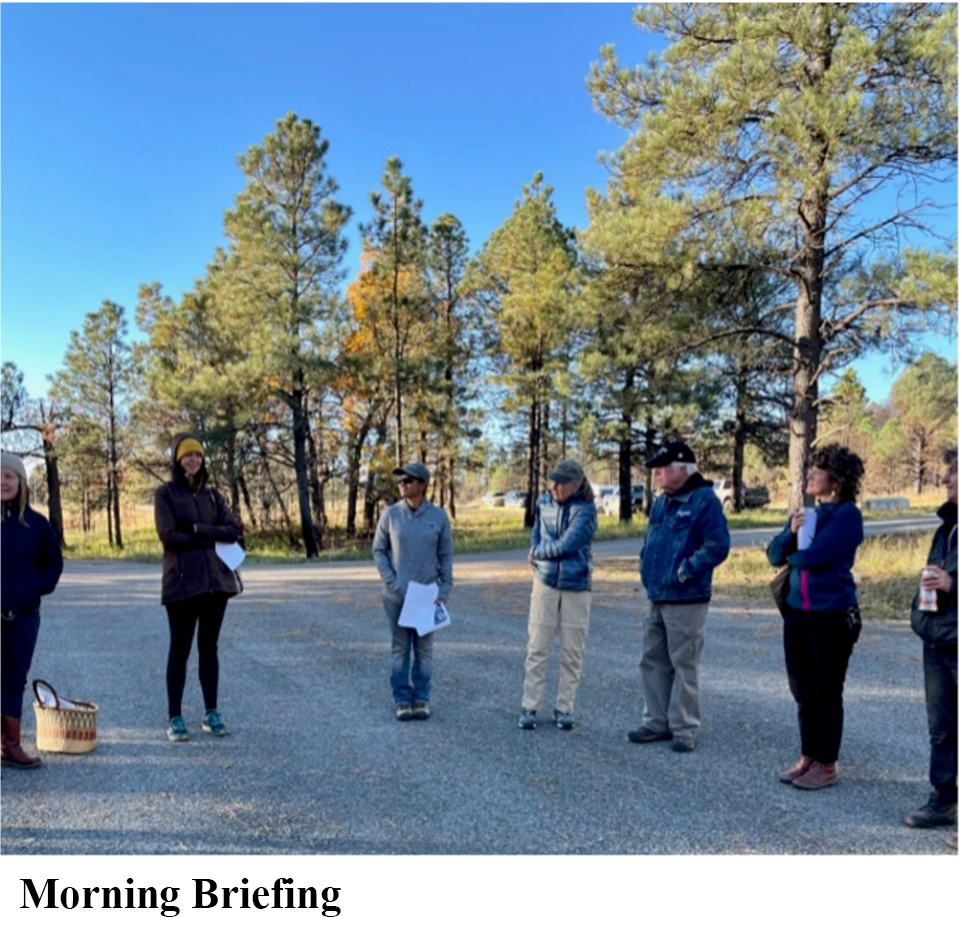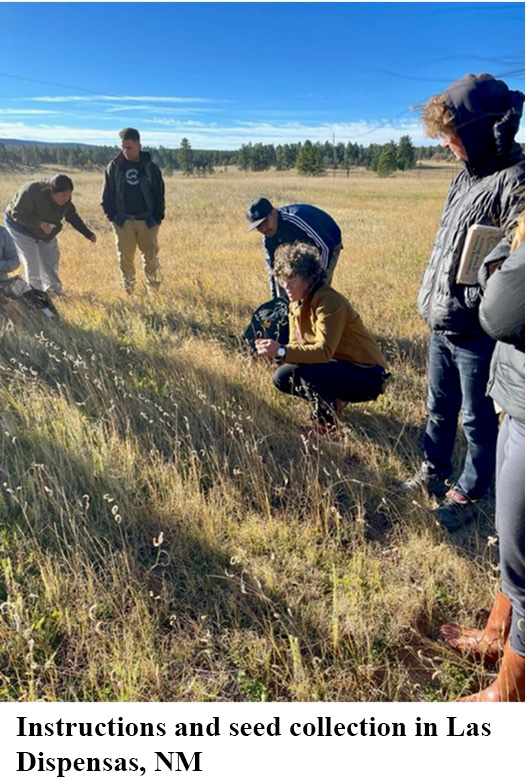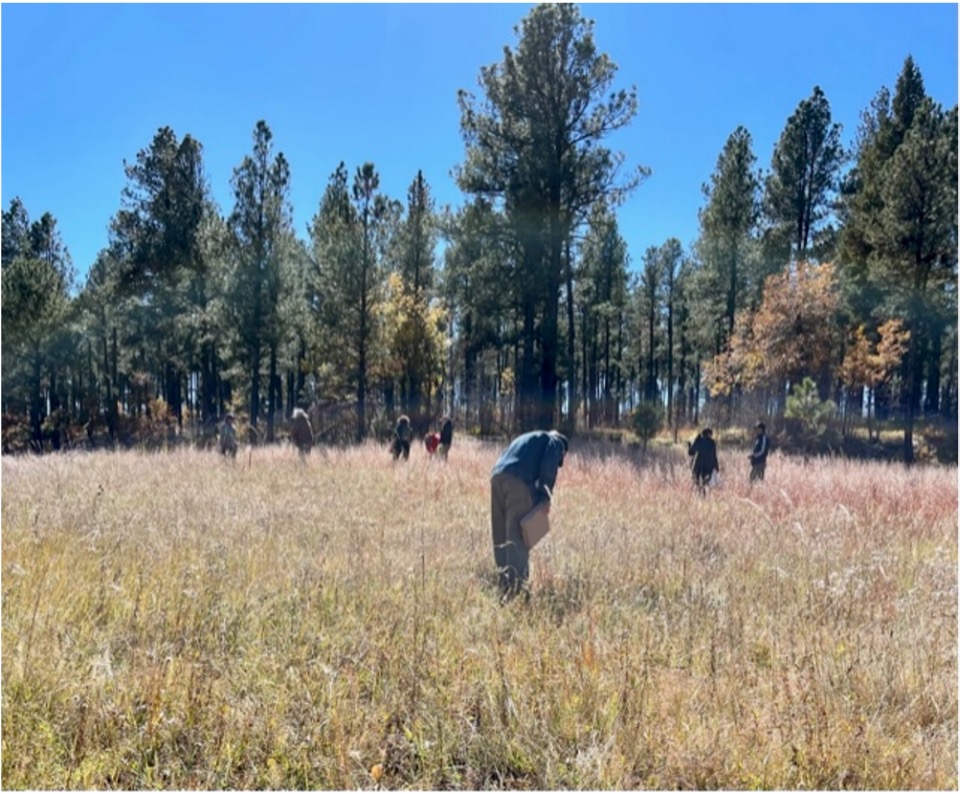An account is required to join the Society, renew annual memberships online, register for the Annual Meeting, and access the journals Practicing Anthropology and Human Organization
- Hello Guest!|Log In | Register
From the Editors
Fire and Flooding
Orit Tamir and Jeanne Simonelli
The National Forest Service-caused Hermit’s Peak Fire began on April 6, 2022 in Las Dispensas, New Mexico. The fire later merged with the Calf Canyon fire (also caused by the National Forest Service) that became the largest fire in New Mexico’s history. On October 20th I (Orit) joined a group of homeowners, volunteers, and instructors on a seed- collecting workshop that took place in and around Las Dispensas. I joined friends and other landowners who were impacted by the Calf Canyon/Hermit’s Peak Fire and subsequent flooding off the burn scar (see August’s SfAA News https://www.appliedanthro.org/publications/news/august-2022/editors for more information about the social, cultural, economic, and biotic impacts). To restore the land and forest, Luna Community College along with New the New Mexico Forest and Watershed Restoration Institute, housed at New Mexico Highlands University have been offering free workshops called “Querencia in Action: Post-Fire Land Restoration” to revitalize the natural vegetation and address soil erosion. This is a community-based effort that started in July 2022 and is ongoing. All the workshops are held on private lands in the impacted areas of New Mexico’s San Miguel and Mora counties. The October 20th workshop focused on seed harvesting of local natural grasses.
collecting workshop that took place in and around Las Dispensas. I joined friends and other landowners who were impacted by the Calf Canyon/Hermit’s Peak Fire and subsequent flooding off the burn scar (see August’s SfAA News https://www.appliedanthro.org/publications/news/august-2022/editors for more information about the social, cultural, economic, and biotic impacts). To restore the land and forest, Luna Community College along with New the New Mexico Forest and Watershed Restoration Institute, housed at New Mexico Highlands University have been offering free workshops called “Querencia in Action: Post-Fire Land Restoration” to revitalize the natural vegetation and address soil erosion. This is a community-based effort that started in July 2022 and is ongoing. All the workshops are held on private lands in the impacted areas of New Mexico’s San Miguel and Mora counties. The October 20th workshop focused on seed harvesting of local natural grasses.
The fire has had widespread sociocultural economic, and biotic impacts on small rural northern New Mexican predominantly Hispano communities that, for the most part, rely on subsistence economy. Shantini Ramakrishnan, Conservation & Restoration Education Project Manager of New Mexico Forest & Watershed Restoration Institute says that the fire destroyed mountain forests that provided firewood, high altitude grazing pastures, latillas for fencing, logs for small lumbering businesses, wood for local construction, Christmas trees, and trees and rock for transplanting, construction, and landscaping. The loss of these  natural resources and the subsistence practices they support makes it impossible for people (mainly Hispanos who are descendants of the conquistadors) and communities to support themselves. Fire-generated out-migration is on the rise and further exacerbates preexisting economic vulnerability and add strain to a shrinking workforce. The economic, biotic, and related sociocultural will have lasting effects on the fire-impacted communities as they attempt to rebuild homes, livelihoods, and a unique regional culture.
natural resources and the subsistence practices they support makes it impossible for people (mainly Hispanos who are descendants of the conquistadors) and communities to support themselves. Fire-generated out-migration is on the rise and further exacerbates preexisting economic vulnerability and add strain to a shrinking workforce. The economic, biotic, and related sociocultural will have lasting effects on the fire-impacted communities as they attempt to rebuild homes, livelihoods, and a unique regional culture.
Since July, the Querencia in Action: Post-Fire Land Restoration community-based project has been facilitated and supported a series of workshops and technical training for landowner that are designed to achieve a number of goals.
-
Increase community capacity in in post-fire rehabilitation and provide opportunities for landowners to participate in the recovery of their own landscapes.
-
Respond to landowners’ needs to gain information and technical expertise for post-fire restoration and flood mitigation.
-
Use demonstration and workshop infield locations to showcase approaches, treat sites, allocate resources more widely and equitably across the fire-impacted landscape, and build goodwill and community acceptance.
-
Introduce pathways for potential future employment in post-fire landscape restoration.
-
Establish partnership with Luna Community College for longer-term workforce development to contribute towards multi-year post-fire recovery.
Per Shantini Ramakrishnan, the workshops will continue as long as landowners are interested. The workshops will also provide foundations for a future certification programs and train residents to lead the long-term recovery work.
 The current series of workshops was funded by Natural Resources Conservation Service (instructors, promotion and outreach materials, advertising, supplies, workshop registration and tracking), NM Forest & Watershed Restoration Institute (landowner engagement from FWRI staff to establish and build relationships to host workshops on working lands in the burn scar, developing curriculum and instructional materials, supplies) and the Conservation Science Center (landowner stipends to prep land for our workshops, per diems, mileage reimbursements, supplies, volunteer stipends).
The current series of workshops was funded by Natural Resources Conservation Service (instructors, promotion and outreach materials, advertising, supplies, workshop registration and tracking), NM Forest & Watershed Restoration Institute (landowner engagement from FWRI staff to establish and build relationships to host workshops on working lands in the burn scar, developing curriculum and instructional materials, supplies) and the Conservation Science Center (landowner stipends to prep land for our workshops, per diems, mileage reimbursements, supplies, volunteer stipends).
If you wish to support these efforts, please use the link to the "Fire Relief Fund" at the Las Vegas Community Foundation, https://www.lvnmcf.com/hermits-peak-wildfire-relief-fund-2/. This is non-profit community-base organization that hopes to establish another fund soon dedicated towards the Long Term Recovery Group. This is the best option for donations. In addition, you may contact Shantini Ramakrishnan shantinir@nmhu.edu for information about how to support the Conservation Science Center.
Down the road from the fires, Pecos National Historic Park was spared the burn and much of the flooding. My (Jeanne’s) season working at the Park is coming to an end. For those of you familiar with southwestern archaeology, Pecos is the site of A.V. Kidder’s famous dig, which yielded the Pecos Pottery classification. Kidder was from the first generation of trained archies, bringing skills to the excavation that he acquired at Harvard University.
Back in the late 70s, I can remember asking my Southwest archeology professor Rich Pailes what the difference was between the cowboy traders and the early archeologists. The former, like Richard Wetherill, dug in sites and sold what was found to the best bidder. The latter, like Kidder, got a grant from some east coast university, museum or foundation, excavated, and sent the artifacts back to the museum.
“Easy,” he answered. “The trained guys kept better notes.”
Here at Pecos, working from 1914 to 1925, Kidder excavated the midden and sent almost 2000 human remains to the Peabody in Massachusetts. There they sat for at least sixty years, with some analysis in 1930 and a revisit in the 90s. In 1990, with the passage of NAGPRA, it became possible for Jemez Pueblo, which absorbed the last Pecos Pueblo survivors in 1835, to request repatriation of the remains to the Park. On May 23, 1999, the ancestors were returned and reburied, along with some of the grave goods that had been buried with them. It was the largest repatriation in US history.
The story of indigenous cultures is imprisoned in museums and institutions worldwide. This week, surfing You Tube, I encountered a broadcast of John Oliver’s HBO show “Last Week Tonight” focusing on museums ( see https://youtu.be/eJPLiT1kCSM ). Oliver begins at what I’ve always called the British Museum of Imperial Booty. After interviewing a number of British and French officials who justify museum collections, the program visits the Chicago Field Museum. A delegation of Native Americans gets to see tribal items that have been sequestered there for years. They do not look pleased.
Pecos is reconfiguring its museum this winter. The new one will tell a more complete story of the lands and people. It will finally include the story of the repatriation. After living at the site for the last three months, I think the ancestors are at rest.

Cart
Search